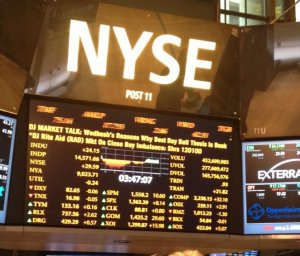The Three Basic Ways to Make Money in the Stock Market
 There are many different ways to make money on the stock market, more than I can tell you about. If you don’t have much money to work with, though, your choices are relatively few. These are the strategies I know about that allow you to invest in stocks with relatively little money. But remember that buying and selling stocks on a regular basis entails risk and most people are not able to manage that risk very well.
There are many different ways to make money on the stock market, more than I can tell you about. If you don’t have much money to work with, though, your choices are relatively few. These are the strategies I know about that allow you to invest in stocks with relatively little money. But remember that buying and selling stocks on a regular basis entails risk and most people are not able to manage that risk very well.
Beware of These Hidden Costs
Before you start buying and selling stocks, study the terms and conditions that you agree to abide by when you sign up with any brokerage. They may require you to make a minimum deposit of a few hundred or few thousand dollars. They may require you to maintain a minimum balance. They may require you to pay a transaction fee every time you buy and sell something through their service.
In order to make money in the stock market you have to earn more through your sales than the combined costs of Buying Shares + Broker Fees + Taxes. Yes, your profits are taxable. You may have to pay a Short-term Capital Gains Tax if you sell a share in less than five years after buying it. You may have to pay a Long-term Capital Gains Tax if you sell a share more than five years after buying it. In the United States you can learn a little more about Capital Gains and Losses from the IRS.
Don’t make the mistake of calculating your profits solely on the basis of difference between what you pay for shares and what you sell them for.
1. Straight Forward Buying and Selling
Every healthy stock has what is called a “trading range”. Savvy investors look for stocks that are at the bottom of their trading range, where there is no imminent negative news about either the company or their business sector. They buy shares at the lowest reasonable price possible.
A good trading range covers at least a few dollars’ difference in price. You have to look at the 52-week trading cycle to see what the range is, but don’t just look at the 52-week low. A trading range is only an approximate pair of upper and lower boundaries. Stocks can dip and spike outside of their trading ranges.
When you buy a stock, it may pay dividends on a quarterly or annual basis. If the stock has a stable history and survives stock market crashes well, then it is better to “Buy and Hold” that stock for at least five years, either reinvesting the dividends in the stock or putting them into other stocks. You have to pay taxes on dividends, too.
If you decide to sell a stock before five years, you want to look for a premium in price (the best possible price above what you paid) or you want to cut your losses shorts. Savvy traders set limits on the prices of their stocks. In other words, they do not allow greed or hope to make their selling choices for them. A common practice is to sell a stock once its price has either risen 10-20% above what you pay or once it has dropped 10-20% below what you paid.
You really have no way of knowing which way a stock price will go, but if the stock is merely following the market down and the company is paying dividends, it may be okay to hold on to the stock through a market downturn. Look at the company’s fiscal history and compare it to past stock market downturns. Look at what their prospects for the near-term future (6-12 months) are.
Investopedia has a good introduction to trading in stocks for people who are not familiar with how that all works.
2. Shorting a Stock
Aggressive traders may decide to “short the market”. This means that you expect the prices of stocks to go down, so you “borrow” shares from your broker and sell them at the current price. Then, after a little time has passed, you buy the shares back and return them to your broker. The broker will issue a “margin call”, meaning it’s time to either pay for the shares you borrowed or return them.
Shorting the market is risky because a stock that WAS in decline when you sold the shares may suddenly start rising in value. In that case, when you buy the shares back you may pay MORE for them than what you sold them for.
As a stock market begins to decline more traders begin shorting stocks. That means competition for selling the shares becomes intense. You may not be able to sell your shares at the price you want. Orders to sell are queued up and executed in turn, but if your sell price is higher than what other people are selling for then your order may never be executed.
Sometimes a trader will speculate that a company stock will decline rapidly. For example, say you invest in pharmaceutical stocks. These companies often experience terrible stock price declines when major drug projects fail to win Food and Drug Administration approval. It is illegal to try to obtain inside information before buying and selling stocks, but let’s say that you see an obscure news story about the company and you decide that could foreshadow the outcome of the FDA review. You can speculate that the stock will tank and short it just before the FDA review results are announced.
This example illustrates an extreme risk because if you guess wrong you will lose a lot of money on the stock. FDA approval of new drugs often has a great positive effect on a pharmaceutical company’s stock.
If you decide to short a stock you should always keep a sufficient cash reserve pay for the stock above the price you paid. Otherwise, if you have no money when your margin is called your broker may seize and sell other securities you own.
Here is a quick explanation of how shorting stocks works from About.com. This is part of a longer article.
3. Buying and Selling Options
People sometimes call these derivatives. The word “options” may confuse some beginning investors because it is used for at least two different kinds of stock contracts. For example, if you take a job with a publicly traded company, they may award you stock options as part of your compensation. These options allow you to buy shares in the company at a set price (called a “strike price”), usually below the expected market value. Although this contract works much the same way as other options contracts, these kinds of options are most often referred to as Employee Stock Options (ESO) and they are treated somewhat differently from other options.
The other kind of options are merely contracts to Buy or Sell stocks at pre-determined prices somewhere in the future. If your contract allows the buyer to decide when the shares will be exchanged it is called a CALL contract. If your contract allows the seller to decide when the shares will be exchanged it is called a PUT contract. Sellers may offer some guarantees (discounts or rebates) if the stock’s actual price at time of exchange is less than what the contract calls for.
With an options contract the buyer is purchasing the exclusive FIRST RIGHT to buy or refuse a block of shares (usually 10) at a set price. That means if the contract agrees on a price of 50 dollars per share and the stock is trading at 60 dollars when it is time for the exchange, the options seller cannot sell those shares for more money or to anyone else unless the buyer agrees to walk away from the contract.
With an options contract the buyer is purchasing an exclusive right to buy, not actual shares. The seller is providing a guarantee that the shares will be available when it is time to fulfill the contract. The option seller either continues to own the shares being contracted OR assumes an obligation to buy the shares and sell them to the option buyer when the contract matures.
Billionaire investor Warren Buffet’s company Berkshire Hathaway has made hundreds of millions of dollars selling PUT options contracts, but even Buffett sometimes guesses wrongly. His company has also LOST hundreds of millions of dollars on options contracts. There is no way to guarantee your success in this kind of stock market trading.
Warren Buffet makes money by reinvesting the the money he receives for those options. He may lose money on the stocks themselves but he sets his maturity dates many years into the future. This is called “working with float” because he can buy and sell the shares he has obligated himself to sell many times during that lockout period. In effect he is selling an obligation to buy-and-sell shares to someone else at a price they believe will be favorable to them at the time the contract matures.
Here is a brief introduction to several options trading strategies you can use if you want to get into this kind of investing.
So What Is The Best Way to Make Money?
I am a big believer in buying index funds rather than individual stocks. As I pointed out in this article about averaging down and this article about when to invest, stock market index funds are more reliable than individual stocks.
And I am very pleased to see that Vanguard, a major brokerage, agrees with me. Their article publishes research that shows just how well index funds perform compared to most mutual funds.
While it is true that some people do very well with speculative investing, most people do not. It is the losers who pay for the gains of the winners. I think the safest way to invest in stocks is to keep your money in the index funds.


